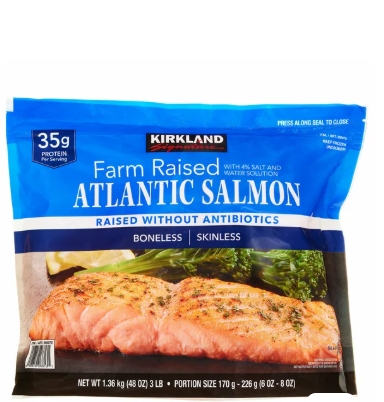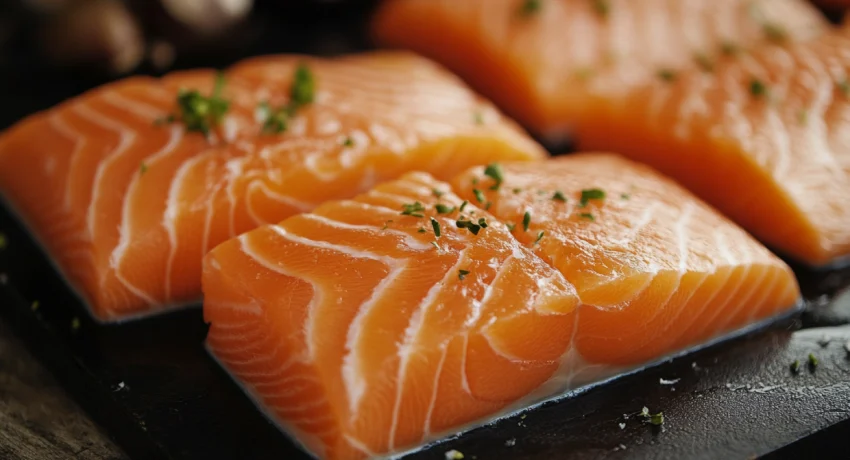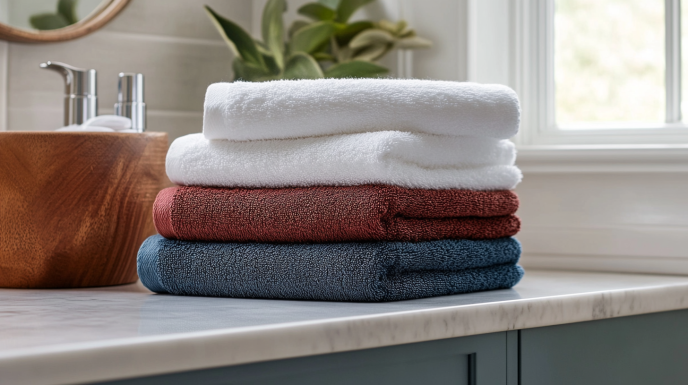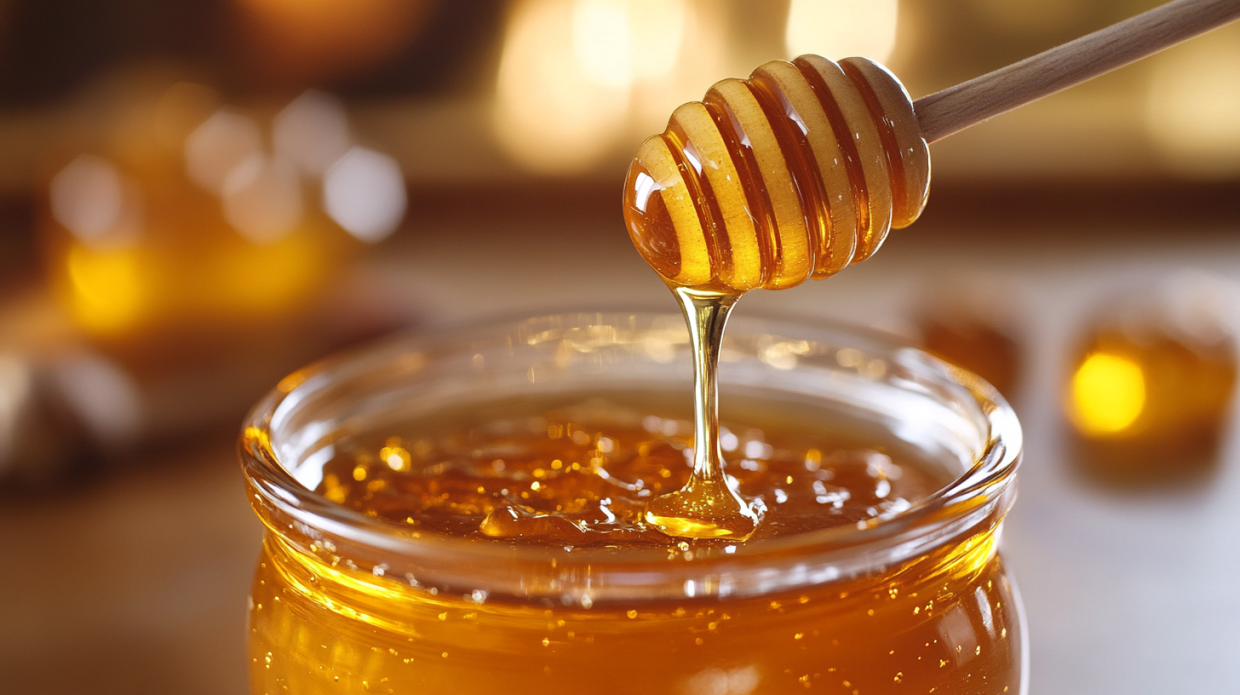
Kirkland Signature Farmed Atlantic Salmon, 6 oz – 8 oz Center-Cut Portion, 3 lbs
- Farmed Atlantic Salmon; Raised without antibiotics; Boneless, skinless; 6 oz – 8 oz center-cut portion size.Read more
Discovering Costco’s Prized Seafood Treasure
In a world of endless seafood options, Kirkland Signature salmon stands as a benchmark for quality, value, and sustainability in the marketplace. As a Costco member and self-proclaimed salmon enthusiast, I’ve spent years exploring the various offerings of this popular protein. Today, I’m sharing everything you need to know about this beloved seafood staple that has found its way into millions of shopping carts and dinner tables across the country.
Let me take you on a journey through the cold, pristine waters where Kirkland salmon begins its story, all the way to the delicious meals you can create in your own kitchen. Whether you’re a longtime fan or considering your first purchase, this comprehensive guide will help you navigate the world of Kirkland salmon with confidence.
The Kirkland Salmon Family: Fresh, Frozen, and Smoked Options
Costco’s Kirkland Signature line offers remarkable variety when it comes to salmon products. Each type serves different culinary purposes and satisfies various preferences:
Fresh Salmon
The fresh salmon counter at Costco is often my first stop during weekend shopping trips. The vibrant, glistening fillets arranged neatly on ice make for an impressive display. Fresh Kirkland salmon typically comes in large center-cut portions with consistent thickness—perfect for even cooking. The flesh exhibits that signature bright orange-pink hue that salmon lovers recognize instantly.
What makes the fresh option particularly appealing is the ability to see exactly what you’re getting. The seafood staff is usually knowledgeable and willing to help select the best pieces or cut specific portions to your liking. I’ve found the fresh salmon to be remarkably clean-smelling—a telltale sign of quality and proper handling.
Frozen Salmon
For convenience and longevity, Kirkland’s frozen salmon options are hard to beat. Available in individually vacuum-sealed portions, these fillets maintain excellent quality and are ready whenever you need them. The flash-freezing process locks in freshness remarkably well, preserving both flavor and texture.
The frozen salmon comes in several varieties including individual fillets, multi-packs, and sometimes even stuffed or seasoned options during seasonal promotions. These products have saved many last-minute dinner situations in my household, thawing relatively quickly under cold running water when needed.
Smoked Salmon
Perhaps one of Costco’s most celebrated seafood offerings is their Kirkland Signature smoked salmon. Available in traditional cold-smoked, hot-smoked, and sometimes specialty flavored varieties, this product consistently receives praise from salmon aficionados.
The cold-smoked salmon is thinly sliced with a silky texture and that distinctive smoky flavor that pairs perfectly with cream cheese, capers, and red onion. The hot-smoked version offers a flakier texture with deeper smoke penetration—excellent for salads or eating straight from the package.
Wild-Caught vs. Farm-Raised: What’s in Your Package?
Kirkland salmon spans both wild-caught and farm-raised options, each with distinct characteristics:
Wild-Caught Kirkland Salmon
The wild-caught selection typically includes sockeye salmon from Alaska, which is known for its deep red color and robust flavor profile. These salmon live natural lives in ocean waters, feeding on marine organisms that give them their characteristic rich taste and color.
The wild-caught offerings represent Kirkland’s commitment to sustainable fishing practices, with most products carrying certifications from reputable organizations like the Marine Stewardship Council (MSC). Wild salmon is typically available seasonally, reflecting natural migration and spawning patterns.
Farm-Raised Kirkland Salmon
The farm-raised Atlantic salmon sold under the Kirkland label primarily comes from controlled aquaculture environments in Norway, Chile, and sometimes Scotland. These salmon tend to have a milder flavor and lighter colored flesh with higher fat content, making them particularly suitable for those new to salmon or seeking a less “fishy” taste.
Costco has made significant strides in ensuring their farm-raised salmon meets increasingly stringent environmental and quality standards. Many of their farm-raised options now carry certifications from the Aquaculture Stewardship Council (ASC) or other regulatory bodies that monitor farming practices.
Price Point: Value That’s Hard to Beat
One of the most compelling aspects of Kirkland salmon is its price point relative to comparable quality products from other retailers. While prices fluctuate seasonally and regionally, Costco typically offers salmon at 20-30% below specialty seafood shops and even other major supermarkets.
Fresh Kirkland salmon generally ranges from $8.99-$12.99 per pound, with wild-caught varieties commanding the higher end of that spectrum. The frozen options offer even greater savings, typically pricing between $6.99-$9.99 per pound when purchased in multi-pound packages.
The smoked salmon represents perhaps the best value in the lineup. The 1-pound package of cold-smoked salmon typically sells for $15.99-$19.99, which is roughly half the price of specialty brands offering similar quality. This pricing strategy has made premium salmon accessible to many households that might otherwise consider it an occasional luxury.
Sustainability: Ocean-Friendly Choices
For environmentally conscious consumers, the sustainability credentials of seafood products are increasingly important. Costco has responded to this concern by making significant commitments to responsible sourcing for their Kirkland salmon.
The wild-caught options, particularly the Alaskan varieties, come from fisheries widely recognized as some of the best-managed in the world. Most carry the blue MSC certification label, indicating the fish were caught using methods that maintain fish populations and minimize ecosystem impacts.
For farm-raised options, Costco has been transparent about their ongoing efforts to improve aquaculture practices. Many of their farm-raised salmon products now come from facilities that limit antibiotics use, reduce environmental impact, and maintain higher standards for fish welfare. The company has publicly committed to increasing the percentage of certified sustainable seafood across their entire range.
A particularly notable aspect of Kirkland’s approach is their traceability. Many packages include information about exactly where the salmon was caught or raised, allowing consumers to make informed choices and research specific regions if desired.
Nutritional Powerhouse: Health Benefits in Every Bite
Salmon’s reputation as a nutritional superstar is well-deserved, and Kirkland’s offerings deliver the full spectrum of health benefits. A typical 3.5-ounce (100g) serving of Kirkland salmon provides:
- 20-25 grams of high-quality protein
- 1,500-2,000 mg of omega-3 fatty acids (EPA and DHA)
- High levels of B vitamins, particularly B12
- Excellent source of selenium, potassium, and phosphorus
- Natural source of astaxanthin (an antioxidant that gives salmon its pink color)
- Vitamin D, which can be difficult to obtain from other food sources
The wild-caught varieties typically offer slightly less fat but more mineral content, while the farm-raised options generally provide higher levels of omega-3s due to controlled feeding. Either choice delivers impressive nutritional value that supports heart health, brain function, and anti-inflammatory processes in the body.
For those watching sodium intake, it’s worth noting that while fresh and frozen unflavored salmon contain minimal sodium, the smoked varieties do have significantly higher sodium levels due to the curing process—something to consider for those on restricted diets.
Flavor Profiles: Pre-Seasoned Options and Natural Taste
Most Kirkland fresh and frozen salmon comes unseasoned, allowing home cooks to customize flavors according to their preferences. The natural flavor of the salmon varies by type:
- Wild sockeye offers a pronounced, rich flavor with lower fat content
- Atlantic farm-raised provides a milder, buttery taste with more fat marbling
- Coho (when available) presents a middle ground with medium fat content and balanced flavor
However, Costco does occasionally offer pre-seasoned options, particularly in their frozen selection. These might include:
- Lemon pepper seasoned fillets
- Garlic herb butter portions
- Teriyaki glazed pieces
- Pesto topped fillets
These convenience options use relatively clean ingredient lists without excessive additives or preservatives, making them a reasonable choice for quick meals without sacrificing quality.
Cooking Kirkland Salmon: Methods for Perfect Results
The versatility of Kirkland salmon is one of its greatest attributes, adapting beautifully to various cooking methods:
Baking
Perhaps the most foolproof method, baking Kirkland salmon at 375°F (190°C) for 12-15 minutes (depending on thickness) yields reliably excellent results. A simple approach of olive oil, salt, pepper, and lemon works wonderfully with the clean flavor of the fish. For even cooking, allow the salmon to come to room temperature for about 15 minutes before baking.
Grilling
Kirkland salmon, particularly the thicker cuts, stands up remarkably well to grilling. The higher fat content of the farm-raised varieties helps prevent sticking and drying out. Using a cedar plank adds another dimension of flavor that complements the natural taste of the fish. Skin-on pieces work best for grilling, as the skin helps hold the delicate flesh together.
Pan-Searing
For a restaurant-quality presentation with crispy skin and moist interior, pan-searing is unbeatable. Starting skin-side down in a hot, oiled pan for about 4-5 minutes, then flipping for just 1-2 minutes more produces a beautiful piece of fish. The key is patting the salmon dry before cooking and using a pan that’s truly hot before the fish goes in.
Air Frying
A more recent favorite method in many households, air frying Kirkland salmon at 390°F (200°C) for 7-9 minutes creates a wonderful exterior texture while maintaining moisture. This method works particularly well for smaller portions or the individually frozen fillets.
Poaching
For those seeking the most delicate preparation, gently poaching Kirkland salmon in a flavorful liquid of white wine, herbs, and vegetable broth preserves its tender texture while infusing subtle flavors. This method is particularly good for serving salmon cold in salads or with sauces.
Dietary Considerations: Gluten-Free and Allergen Information
Good news for those with dietary restrictions: unflavored Kirkland salmon is naturally gluten-free and fits into most specialized diet plans. The plain fresh and frozen varieties contain no additives or ingredients beyond the fish itself, making them suitable for:
- Gluten-free diets
- Paleo and Whole30 approaches
- Keto and low-carb regimens
- Mediterranean diet protocols
However, it’s always wise to check labels on the pre-seasoned or marinated options, as these may contain ingredients with gluten or other allergens. The smoked varieties generally use minimal ingredients (typically just salt, sugar, and natural smoke), but again, verification via the package labeling is recommended.
For those with seafood allergies, it’s worth noting that Kirkland salmon is processed in facilities that handle other seafood, so those with severe allergies should exercise appropriate caution.
Consumer Feedback: What Shoppers Are Saying
The court of public opinion has largely ruled in favor of Kirkland salmon products. Online reviews, food forums, and conversations at Costco’s salmon counter reveal consistent themes:
Praise for:
- Consistent quality and freshness
- Excellent value compared to specialty fish markets
- Convenient packaging, particularly the individually vacuum-sealed portions
- Clean flavor without overwhelming “fishiness”
- Reliable availability throughout the year
Occasional critiques regarding:
- Variation in portion sizes in some packages
- Seasonal fluctuations in price
- Limited availability of certain wild varieties outside peak seasons
- Rare instances of less-than-ideal freshness in some store locations
Overall, Kirkland salmon maintains an impressive reputation among both everyday consumers and food enthusiasts. Professional chefs have been spotted in Costco aisles selecting these products, which speaks volumes about their quality-to-price ratio.
Shelf Life and Storage: Maximizing Freshness
Understanding proper storage is essential for getting the most from your Kirkland salmon purchase:
Fresh Salmon
Fresh Kirkland salmon should ideally be cooked within 1-2 days of purchase. For optimal freshness:
- Keep refrigerated at 32-34°F (0-1°C) if possible
- Store in the original packaging until ready to use
- Place in the coldest part of your refrigerator, usually the back of the bottom shelf
- If not cooking immediately, consider freezing portions you won’t use right away
Frozen Salmon
The individually vacuum-sealed frozen portions maintain excellent quality for up to 6 months in a well-maintained freezer. For best results:
- Keep at a consistent temperature of 0°F (-18°C) or below
- Avoid thawing and refreezing, which significantly deteriorates texture
- Thaw in the refrigerator overnight for best results, or under cold running water if pressed for time
Smoked Salmon
Unopened smoked salmon packages typically have a refrigerated shelf life of 2-3 weeks, as noted on the packaging. Once opened:
- Consume within 3-5 days for optimal quality
- Keep tightly wrapped to prevent drying
- Store in the coldest part of the refrigerator
Skin On or Off: Options for Different Preferences
Kirkland offers both skin-on and skinless options to suit different cooking methods and preferences:
Skin-On Benefits:
- Acts as a natural barrier between the heat source and delicate flesh
- Contains additional omega-3 fatty acids
- Creates a crispy texture when properly cooked
- Helps hold the fish together during cooking, especially on the grill
- Often preferred by chefs for its flavor contribution
Skinless Benefits:
- Ready to eat without additional preparation
- Preferred for recipes where skin texture isn’t desired
- Often chosen for poaching, soups, or salmon cakes
- Generally preferred by those who dislike the stronger flavor of the skin
The fresh salmon counter usually offers both options, while frozen packages may vary. If you have a strong preference, the seafood staff can typically remove or leave the skin according to your wishes.
Competitive Landscape: How Kirkland Compares to Other Brands
In the crowded salmon market, Kirkland has established a distinct position that balances quality with accessibility:
vs. Premium Specialty Brands (e.g., Vital Choice, King Salmon Co.)
- Kirkland offers 30-50% lower pricing
- Comparable quality in fresh offerings
- Slightly less specialty variety (no rare species like king salmon)
- Less detailed information about specific catch methods
vs. Other Supermarket Brands (e.g., Whole Foods, Trader Joe’s)
- Similar or better quality at lower price points
- Larger portion sizes typical in Kirkland packages
- More consistent availability year-round
- Typically fresher due to Costco’s rapid inventory turnover
vs. Budget Seafood Options
- Significantly higher quality for marginally higher cost
- Better sustainability credentials
- Superior texture and flavor
- Fewer additives and preservatives
This positioning has helped Kirkland capture a substantial market share across different consumer segments, from value-conscious shoppers to quality-focused culinary enthusiasts.
Packaging Technology: Keeping Salmon at Its Best
The packaging of Kirkland salmon reflects thoughtful design aimed at preserving quality and convenience:
Fresh Salmon
Fresh cuts are typically displayed on food-safe trays covered with clear plastic wrap in the refrigerated cases. Once selected, they’re wrapped in butcher paper with an additional plastic outer layer to prevent leakage.
Frozen Salmon
The individually vacuum-sealed technology used for frozen portions represents one of the most significant innovations in retail seafood. Each portion is sealed in a high-barrier film that:
- Prevents freezer burn
- Locks in moisture
- Enables quick thawing of single portions
- Reduces waste by allowing consumers to use only what they need
Smoked Salmon
The smoked varieties come in resealable packages that maintain freshness after opening. The packaging typically includes oxygen barrier films that significantly extend shelf life by preventing oxidation, which would otherwise rapidly degrade both flavor and color.
Raw Consumption: Sushi-Grade Considerations
A common question among seafood enthusiasts is whether Kirkland salmon is suitable for raw preparations like sushi, sashimi, or ceviche. The answer requires some nuance:
While Kirkland’s fresh salmon is of high quality, it is not specifically designated as “sushi-grade” or treated for parasites in the way that specialized sushi suppliers process their fish. Traditional sushi preparations rely on fish that has been commercially frozen to very low temperatures (-31°F/-35°C or below) for specific durations to eliminate parasite risks.
The regular frozen Kirkland salmon, while frozen, may not meet these specific temperature requirements for safe raw consumption. For this reason, it’s generally recommended to cook Kirkland salmon before eating unless you’ve confirmed with store staff that a particular batch has been processed specifically for raw consumption.
If you’re determined to use Kirkland salmon for raw preparations, the safest approach would be to:
- Purchase the freshest possible fillets
- Freeze them at home at the coldest setting for at least 7 days
- Use proper sushi preparation techniques including very clean cutting surfaces and tools
Even with these precautions, there remains some level of risk compared to fish from specialized sushi suppliers.
Culinary Inspiration: Recipes That Showcase Kirkland Salmon
The versatility of Kirkland salmon makes it suitable for countless recipes across various cuisines. Here are some tried-and-true preparations that highlight its quality:
Simple Herb-Roasted Salmon
A foolproof preparation that lets the natural flavor shine:
- Kirkland salmon fillets
- Olive oil
- Fresh dill, parsley, and chives
- Lemon zest and juice
- Sea salt and freshly ground pepper
Roast at 375°F for 12-15 minutes for perfectly moist, flavorful results.
Asian-Inspired Glazed Salmon
Sweet, savory, and slightly spicy:
- Kirkland salmon portions
- Mixture of soy sauce, honey, ginger, garlic, and a touch of sriracha
- Sesame seeds and green onions for garnish
Brush with glaze before and during baking or grilling.
Mediterranean Salmon Bowl
A complete meal built around salmon:
- Grilled Kirkland salmon
- Quinoa or couscous base
- Cherry tomatoes, cucumber, red onion, and kalamata olives
- Feta cheese crumbles
- Lemon-dill yogurt sauce
Perfect for meal prep and lunches.
Smoked Salmon Breakfast Board
An impressive spread for brunches:
- Kirkland smoked salmon
- Assortment of bagels
- Cream cheese, capers, red onion, and dill
- Hard-boiled eggs
- Sliced tomatoes and cucumbers
Simple but elegant for entertaining.
Salmon Burgers
A delicious alternative to traditional burgers:
- Finely chopped fresh Kirkland salmon
- Panko breadcrumbs
- Dijon mustard, mayonnaise, and lemon zest
- Fresh herbs and minced shallot
- Form into patties and pan-fry until golden
Serve on brioche buns with avocado and arugula.
Bulk Buying: Family-Sized Options and Freezing Tips
One of Costco’s defining characteristics is bulk packaging, and Kirkland salmon is no exception. The typical packaging includes:
Fresh Salmon
- Whole sides of salmon (2-3 pounds)
- Family packs with multiple large fillets (3-5 pounds total)
Frozen Salmon
- Multi-pound bags of individually vacuum-sealed portions (typically 6-10 fillets)
- Occasionally bulk boxes of salmon burgers or seasoned portions
Smoked Salmon
- 1-pound packages (significantly larger than standard grocery store sizes)
- Sometimes available in party platters during holiday seasons
For those not feeding large families, proper portioning and freezing is key to taking advantage of these larger packages without waste:
- Portion fresh salmon into meal-sized pieces immediately after purchase
- Wrap each portion tightly in plastic wrap, then place in freezer bags
- Remove as much air as possible from packages to prevent freezer burn
- Label with the date and use within 3 months for best quality
- Thaw in the refrigerator overnight rather than at room temperature
Geographical Origins: Tracing Kirkland Salmon to Its Source
The origin of salmon significantly impacts its flavor profile, nutritional content, and environmental footprint. Kirkland sources from several key regions:
Alaska
The majority of wild-caught Kirkland salmon comes from Alaskan waters, primarily from:
- Bristol Bay (known for sockeye salmon)
- Southeast Alaska (various species including coho)
- Copper River (when available seasonally)
These fisheries are renowned for their strict management and pristine waters.
Norway
A significant portion of Kirkland’s farm-raised Atlantic salmon originates in Norway’s fjords, where aquaculture practices have been refined over decades. Norwegian salmon is known for its consistent quality and stricter farming regulations compared to many other producing countries.
Chile
Another source of farm-raised salmon, Chilean aquaculture operations supply Kirkland with Atlantic salmon at competitive prices. Costco has worked with these suppliers to improve practices and sustainability over the years.
Scotland
Occasionally, particularly for smoked varieties, Kirkland sources from Scottish farms known for premium quality and traditional smoking techniques.
Each origin is typically noted on the packaging, allowing consumers to make informed choices based on personal preferences regarding taste, environmental concerns, or support for particular regions.
Additives and Preservatives: What’s Really in Your Salmon?
For consumers concerned about food additives, Kirkland salmon offers relatively clean options:
Fresh and Plain Frozen Salmon
- Contains no additives or preservatives
- No color enhancement or artificial ingredients
- May occasionally have anti-oxidants like tocopherols (Vitamin E) to maintain freshness, but these are naturally derived
Seasoned or Marinated Options
- Contain herbs, spices, and flavorings as noted on labels
- Generally avoid artificial preservatives
- May include natural flavor enhancers like lemon or garlic extracts
Smoked Salmon
- Contains salt and sugar for the curing process
- Natural wood smoke (no liquid smoke flavorings)
- May include small amounts of natural preservatives like sodium nitrite in some varieties
This relative lack of additives aligns with Costco’s broader approach to their Kirkland Signature line, which generally emphasizes higher quality ingredients and fewer artificial components than comparable mass-market brands.
Availability: In-Store, Online, and Delivery Options
As consumer shopping habits evolve, so too have the ways to purchase Kirkland salmon:
In-Store Purchase
The traditional approach remains popular, with the advantage of being able to visually inspect fresh salmon before purchase. Availability is consistent year-round, though specific varieties may rotate seasonally.
Costco.com and Instacart
Online ordering has expanded significantly, with options including:
- Same-day delivery in many markets
- Frozen salmon available for shipping to most locations
- Occasional special offerings not found in-store
Costco Business Centers
For restaurants or large families, Costco Business Center locations offer:
- Larger bulk packaging
- More consistent sizing for food service
- Additional specialty cuts sometimes not available in regular warehouses
Seasonal Availability Patterns
While some form of Kirkland salmon is always available, there are seasonal patterns worth noting:
- Wild varieties are most abundant and affordably priced in summer months
- Holiday seasons typically feature special smoked salmon gift packs
- January often sees promotions on frozen options aligning with healthy eating resolutions
Certifications and Standards: Ensuring Quality and Sustainability
For consumers navigating the complex world of seafood sustainability, certifications provide valuable guidance. Kirkland salmon features several important certifications:
Marine Stewardship Council (MSC)
The blue MSC label appears on much of Kirkland’s wild-caught salmon, indicating:
- Fish populations are maintained at healthy levels
- Environmental impacts are minimized
- Fisheries are managed effectively with regular assessments
Aquaculture Stewardship Council (ASC)
This certification appears on some farm-raised options, verifying:
- Responsible use of feed and resources
- Limited use of antibiotics and chemicals
- Consideration of local environmental impacts
- Fair labor practices
Best Aquaculture Practices (BAP)
Another certification found on farm-raised Kirkland salmon that evaluates:
- Environmental responsibility
- Social accountability
- Food safety
- Animal welfare
Alaska Seafood Marketing Institute (ASMI)
This designation confirms the salmon is:
- Harvested from Alaska’s sustainable fisheries
- Processed according to strict quality standards
- Fully traceable from boat to plate
These certifications reflect Costco’s response to growing consumer demand for transparency in seafood sourcing and their commitment to maintaining sustainable options as part of their long-term business strategy.
Conclusion: Why Kirkland Salmon Deserves a Place in Your Kitchen
After exploring every aspect of Kirkland salmon—from its origins in cold northern waters to the myriad ways it can be prepared in your kitchen—it’s clear why this product has earned such a devoted following among Costco members.
Kirkland Signature salmon successfully balances quality, value, and sustainability in a way few other seafood products manage to achieve. For health-conscious consumers, the nutritional benefits alone make it worthy of regular inclusion in meal planning. For culinary enthusiasts, the consistent quality provides a reliable foundation for everything from simple weeknight dinners to sophisticated entertaining.
As with any food product, personal preferences for taste, texture, and origin will vary. The beauty of the Kirkland salmon line is its breadth—offering options to satisfy different palates, cooking styles, and ethical considerations.
Whether you’re reaching for the convenience of individually portioned frozen fillets, selecting a special cut from the fresh seafood counter, or adding the smoked variety to your brunch spread, Kirkland salmon represents one of the best values in the premium protein category. In a marketplace often forcing consumers to choose between quality and affordability, this product line stands as a welcome exception to that frustrating rule.
The next time you find yourself at Costco, perhaps the salmon counter deserves a closer look—your taste buds, your wallet, and quite possibly the oceans themselves will thank you.




